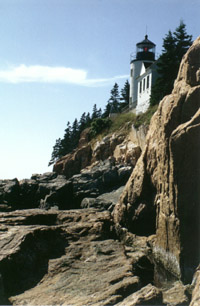![]()
|
The living things (organisms) near the top are exposed to the air much of the time while those near the bottom are usually submerged.
Near the top of the rocks, rough periwinkle snails graze on dark stains of algae. Below them, barnacles cement themselves to the rocks and capture microscopic plankton with their feathery legs. Rockweeds cover the lower surfaces, where mussels attach themselves to these plants with silken threads. In the tidal pool, ribbons of marine grass, brown kelp, sea stars, anemones, crabs, and small fish thrive.
With every tide and season, the populations of organisms change. In the cold months of winter, lobsters head for the stable temperatures of the deep sea while the warming of spring brings pollack to hunt for smaller fish. In turn, people hunt the pollack. Humans have been so successful in pursuing the pollack that their continued survival in this ecosystem is threatened.
